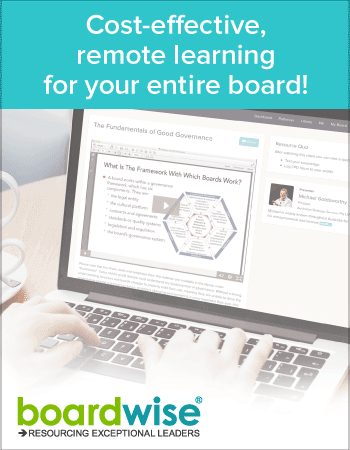Company Secretary Playbook: The Art of Reviewing and Refining Board Papers
-
boardpacks
Board Packs Company Secretary Playbook: The Art of Reviewing and Refining Board Papers
High-impact board papers directly enable insightful discussions and sound governance oversight and decision making.
How can board secretaries, executives and others who support the board produce high-quality papers before they are inserted into the board pack and reach the boardroom?
Crafting papers that succinctly deliver what directors need to know is an art that takes time to perfect. However following a rigorous review, editing and refinement process will you help you produce sound papers that deliver.
1. Read the Entire Paper, Edit Later
Resist the urge to stop and edit mid-review. Read through the draft entirely first before making any changes. This allows you to objectively consider the complete flow, continuity of arguments, and comprehensive content before getting into details. Jumping straight into edits risks losing perspective on linkages across sections.
Review papers actively by taking notes on overall messaging and gaps to address in full revisions later. But refrain from word smithing or finessing until any global issues are addressed.
A holistic read-through upfront prevents fragmented edits in isolation. You can then stand back and view papers as integrated stories rather than disconnected details.
2. Analyse Alignment with Board Priorities Before Making Changes
After an initial comprehensive read-through without edits, pause to reflect on alignment before diving into revisions.
First consider whether the paper’s purpose and scope warrant board-level time and attention. Then determine whether it aligns to strategic priorities and whose purview (board or executive) it falls within.
Specifically:
-
Does the core issue require the board’s expertise due to significant strategic, financial, legal, regulatory or reputational considerations? Or would management evaluation suffice? Mismatched or redundant reports waste precious boardroom time and attention.
-
Does information presented directly relate to and address strategic priorities or current board priorities around risk exposures, performance indicators, compliance obligations, advisor guidance, or issues flagged in previous meetings?
This alignment check avoids inefficiently improving papers with dubious board relevance. It also helps to reduce the board expending precious time on management or operational concerns.
The aim should be to avoid funnelling operational details up the chain simply because the paper has been written. Working to applying a strategic and board-level lens filters out papers that are not at a strategic level.
An alignment assessment before major editing saves effort better spent strengthening fully board-relevant papers.
3. Rewrite and Reorganise - Don’t Just Tweak
With alignment confirmed, dive into substantive drafting. But avoid superficially word smithing at sentence level without reconsidering overall structure and flow. Whilst polish is important, also rewrite, rearrange, or discard entire sections as needed to crystallise logical flow and key points.
Ruthlessly cull waffle, repetition, and operational minutiae not relevant to the board. Consolidate fragmented points into unified narratives. Discard or move secondary points obscuring core messages. Sharpen arguments by trimming wordiness and homing in on critical insights directors must consider.
Rewrite rambling sections for punchy clarity. Move analysis of risks and mitigations closer to proposals. Weave in necessary data seamlessly rather than cordoning it off. Synthesise complex information into simple visuals and summaries. Above all, ensure purpose and desired guidance are immediately clear. This is where a clear board paper template is a must. Providing a board paper template to everyone who will be preparing a board paper helps make editing and review easier.
4. Verify Data Quality Before Finalizing
Before finalising any significant data, double check reliability, methodology, age, and source. Validate any research cited. Ensure financial figures, performance metrics, risk measures, and projections reflect the latest verified inputs available, not outdated artifacts or assumptions.
Probe the evidence basis for recommendations:
- Do claims rely on anecdotes versus robust sample sizes?
- Are data discrepancies rationalized or ignored?
- Are alternative viewpoints explored to avoid bias blind spots?
- Would conclusions substantially change if underlying contexts shifted?
This data quality assurance avoids undermining otherwise sound arguments with flimsy or dated supporting evidence. Caveat any unverified data as provisional pending review if inclusion before board meeting is essential.
5. Edit Grammar, Styles and Formatting Flaws
With substantive content refined through rewriting and realignment, polish the paper by editing grammar, spelling, punctuation, formatting, styles, and visual presentation issues.
Work to eliminate small but glaring oversights that undercut perceived professionalism and operational excellence:
- Fix typos, missing words, spelling errors.
- Correct inconsistent capitalisation and tenses.
- Use active voice and present tense.
- Verify correct pronoun usage like he/she.
- Check abbreviation definitions match first uses.
- Ensure list punctuation (commas, dashes, periods) is consistent.
- Avoid overusing passive voice, jargon and wordy phrases.
- Adopt a formal but simple style suited to concise board reading.
- Break large walls of text into readable paragraph chunks.
- Use standard templates for consistency across papers.
- Check font usage, colour schemes, and branding elements align with corporate guidelines.
These finishing touches combine readability and polish.
6. Review Visual appeal and Accessibility
Scrutinise overall visual presentation and accessibility.
- Are headings, graphs and images well-integrated with surrounding text?
- Do they convey key statistics and relationships at a glance?
- Can colourblind readers sufficiently interpret coloured charts?
Build in white space between sections and around charts to improve visual appeal and scannability. Avoid blocks of heavy text. Use page numbers, footers and contents pages to ease navigation through lengthy documents.
PDFs should be generated with adequate proper colour/contrast ratios. Enable in-doc searching and magnification (using a board portal will mean this is done for you). This promotes inclusive accessibility for diverse directors.
7. Verify Overall Flow and Transitions
Conduct one last pass focused solely on continuity and flow of ideas across section transitions.
- Do arguments logically build on each other?
- Are key statistics, reasons and results presented in optimal sequence
- Do transitional phrases helpfully guide readers between concepts?
Smooth out any remaining abrupt thematic jumps, missing explanations, or unclear linkages. Verify cross-references are correctly linked. The goal is a polished narrative flow allowing directors to efficiently absorb reasoning and data relationships.
8. Establish Editorial Quality Standards
Institutionalise these processes into formal quality expectations for board papers. Create checklists of required style guidelines, data reliability standards, mandatory accessibility features, and other quality criteria that all papers must meet before going to the board.
The easiest way to ensure these is to provide board paper templates incorporating these upfront.
Work hard to make papers requiring significant post-submission changes the exception not the norm. Celebrate contributors who consistently meet quality thresholds on time as examples. Rigorous standards for “board-ready” papers improve governance discipline organisation-wide.
9. Continually Strengthen Review Skills
Like any art, reviewing and editing skills require continual honing. Here are further ways to improve your ability to produce consistently excellent board papers:
- Regularly seek directors’ anonymous input on board pack quality.
- Maintain openness to critique of reviewer blind spots.
- Attend writing workshops
- Attend governance events and webinars.
- Enrol in ongoing director professional development programmes.
- Expand your reference library by talking to others who prepare board papers.
- Leverage digital tools to allow version control and commenting.
Make upgrading you and your teams capabilities priority by ensuring that time and a budget is allocated for professional development.
Elevating Strategic Value
Factoring time for robust reviews into the board paper creation timeline and planning is crucial. Following a methodical routine improves quality exponentially while building governance team capabilities.
By spending time upfront aligning, refining, and polishing papers, the strategic value created through subsequent board discussions and oversight rises substantially.
Papers that succinctly deliver what directors need to know in a navigable and accessible form lead to more engaged and informed board guidance.
Additional Resources
Welcoming and Initiating New Board Members
Company Secretary Playbook: Effective Board Meetings
Why Miscommunication Happens Among Directors
Streamlining the Work of the Board
Frequently Asked Questions
How do you manage board papers?
Board papers can be managed by having a central repository or board portal for digitally storing and accessing the papers.This provides a single source of truth that board members can access.
Follow up is crucial before meetings to confirm whether members have received and reviewed the board packs. Unreceived papers can be resent and members reminded to read materials in time.What are the objectives of board paper?
The objectives of a well-constructed board paper are multifaceted. Fundamentally, the paper must provide board members with the necessary information and context to make fully informed decisions. It enables preparation before the meeting by briefing directors on a specific topic and outlining relevant background.
Board Papers should clearly present important recommendations that require approval by the board. Additionally, they facilitate governance functions like oversight of operations, risk management, financial controls and more. An effective board paper supports open discussion of strategically important items, provides justification for management proposals, and allows the board to fulfil its legal and regulatory duties.How do you write a board paper?
There are a few key steps to writing effective board papers. First, clearly outline the purpose, recommendations, and any actions or decisions needed from the board. Provide relevant background and context so the rationale is understood. Present supporting facts, data, analysis, and other substantive information. Include discussion of related risks, challenges, and proposed mitigation measures.
Use clear, succinct language and maintain a simple, logical structure. Incorporate graphs, charts or other visuals if helpful to convey information. Allow adequate time for review and feedback before finalising the paper. When relevant seek input from subject matter experts.How do you prepare a board paper?
Thorough preparation is crucial for high quality board papers. It begins with determining the precise information needs based on the meeting agenda and decisions to be made. Data must be diligently compiled from multiple sources and inputs coordinated across departments. Robust analysis is synthesised to inform recommendations.
Management should provide clear direction while seeking diverse perspectives on proposals. Technical information must be translated into an accessible presentation. Formatting should follow company standards and convey the appropriate image. Adequate time is required for review, feedback and iterative refinement of the content before papers are finalized. Approvals through relevant channels are needed before timely distribution to the board several days prior to meetings.What makes a good board paper?
Several key attributes define a well-constructed board paper. It should be concise yet provide sufficient context and reasoning behind recommendations so the board can make informed decisions. The paper is clearly structured with an executive summary, logical flow, and consistent formatting. Relevance to strategic priorities, performance metrics, risk management, and governance oversight is addressed. Data-driven analysis and insights are presented without extraneous detail. Clear recommendations are highlighted requiring discussion or sign-off. Visual elements illustrate key points.
A good paper facilitates productive discussion rather than providing a definitive prescription. It enables the board's governance role rather than direct management. Overall, a high-quality board paper exhibits rigorous preparation, sharp focus, clarity, and serves the objectives of accountability and transparency. -



